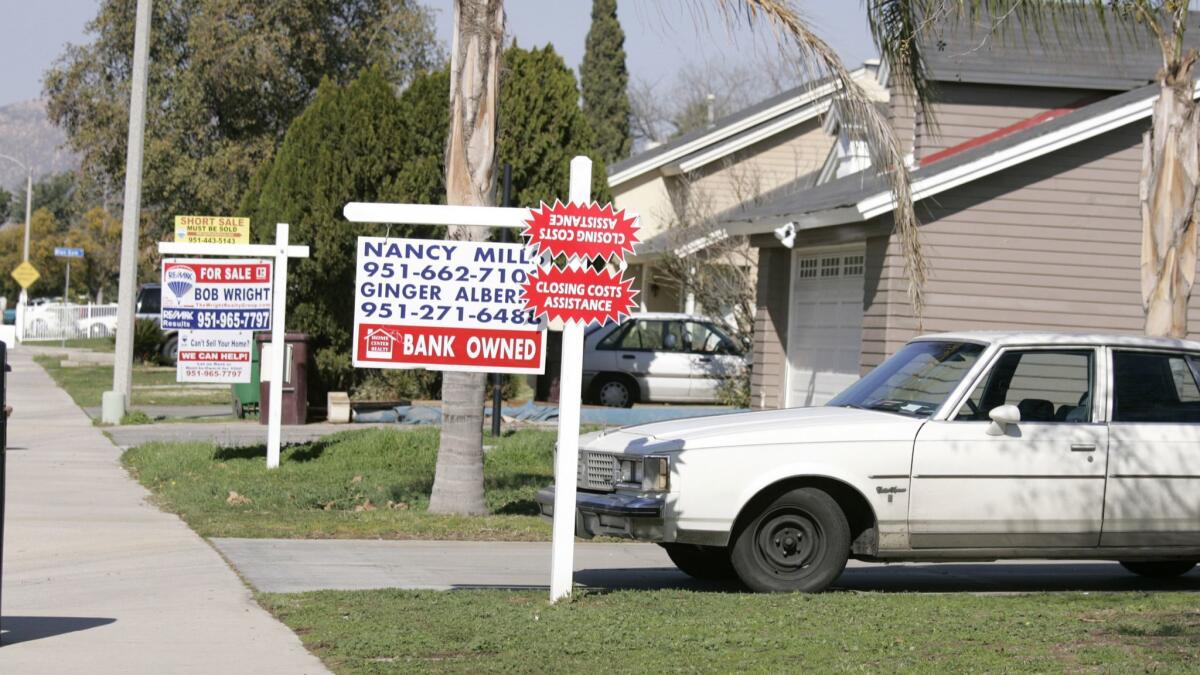Another Southern California home-price boom is cooling. Is a crash looming?

- Share via
The Southern California housing market has been on a nearly seven-year tear, with prices in many communities reaching all-time highs.
But now, as mortgage rates rise, the boom appears to be fading. Sales are dropping; inventory is swelling; more sellers are scaling back their ambitious asking prices.
The annals of postwar Southern California real estate history are full of boom-and-bust cycles, with periods of sharp price appreciation that suddenly skid to a halt. Whether those ups and downs offer any guidance — or hope — for today’s homeowners is a subject for debate.
Some of those who study the housing market predict annual price increases will slow. Others think values could dip. But there is general agreement that a meltdown is not in the offing, given a healthy economy and dearth of home building. The current slowdown, said Christopher Thornberg of Beacon Economics, “is a bump in the road.”
Of course, that’s what some said before the last two busts, in the early 1990s and mid- to late 2000s.
First the good news: There is little reason to believe a bubble anything like the one that popped in 2007 has formed or is forming now.
Last decade, the region was several years into a real estate upswing when prices accelerated. They increased at double-digit rates for six years, fueled by a wave of risky, even predatory, lending. Borrowed money could be used for an entire down payment. Lenders didn’t require proof of income. Low “teaser” rates lured homeowners, but socked them later with huge payments. In some cases, the loan principal that homeowners owed even grew, because their payments didn’t cover interest.
Homeowners soon missed payments and, when the home-equity train slowed, couldn’t refinance either. Defaults rose and the market went into a tailspin. John Burns, a longtime consultant for major home builders, said the housing downturn might have had a “soft landing” if it had remained there. But to stoke the mortgage furnace, bankers had carved up those risky loans and resold them to investors with credit ratings that often hid the potential for default. Risk spread through the financial system, unnoticed by many until it triggered the worst downturn since the Great Depression. Prices across the six-county region ultimately plunged 51%, according to CoreLogic.
This time around, the risk of a crash from overborrowing is minimal, if not nonexistent, experts said. Reforms after the financial crisis dramatically tightened lending standards. Today, even though lending has eased somewhat, borrowers are more likely to be able to afford their loans.
That’s borne out in the data:
- Mortgage lending is relatively restrained. Last decade, total mortgage debt consistently grew by double digits. In the second quarter, those debts rose only 3.5% from the same period a year earlier, Federal Reserve data show.
- Homeowners aren’t as squeezed. Total U.S. mortgage payments in the second quarter accounted for 4.2% of total disposable personal income, the lowest level in at least 38 years. The rate was in the 6% range for most of the mid-2000s bubble, and it hit 7% just before the crash.
- Borrowers are less risky. The median credit score for those taking out a mortgage in the second quarter was 760, compared to a bubble-era low of 707.
“I don’t think we need to worry this time around about a bursting of a credit bubble,” said Stuart Gabriel, director of the Ziman Center for Real Estate at UCLA. “We can cross that factor off the list.”
A more conventional way for Southern California housing booms to end is through an economic recession. That’s what happened 30 years ago.
In the mid- to late 1980s, Southern California home prices had a remarkable run-up. Builders responded by opening vast tracts in the Inland Empire and Antelope Valley.
Concerns over affordability were growing when military cutbacks at the end of the Cold War hammered the region’s sizable aerospace industry. The housing market was already softening before the worst of the cuts. But job losses accelerated and a national recession arrived in the summer of 1990.
Because of its large concentration of aerospace and other military contractors, Southern California suffered more than the rest of the state and the country. By January 1994, L.A. County alone had lost nearly 550,000 jobs and the economy shifted away from manufacturing toward services.
Nationally, the early 1990s recession pushed home prices down slightly, on a year-over-year basis, for 14 months, according to the Case-Shiller index. In Los Angeles and Orange counties, prices fell each month for nearly six years.
“It was really a function of a structural shift in the way our economy operates,” said Jordan Levine, an economist with the California Assn. of Realtors.

Today, the local economy is more diverse than in the early 1990s and can better weather a hit to one specific industry, experts said. And despite concerns over the trade war with China and a volatile stock market, economic indicators remain strong. In Los Angeles and Orange counties, unemployment is at 4.6% and 2.8%. In the Inland Empire, the jobless rate stands at 4.1%. Those areas have added a combined 100,000-plus jobs in the last year.
Thornberg of Beacon Economics cited economic strength and a shortage of housing in predicting that prices would keep rising, just at a slower pace.
In the first eight years of the 1980s, for example, developers in California added one new home for every three new residents, according to data from the state Department of Finance. So far this decade, that ratio is one new home for every five new residents.
Prices in L.A. County have grown an average of 11.4% each year since 2012, according to CoreLogic. That has left only 22% of L.A. County households able to afford the median-priced home in the third quarter, according to the California Assn. of Realtors — but that’s better than 9% during the bubble, when mortgage rates were around two percentage points higher. Price appreciation in the first six years of the 2000s averaged out to nearly 28%.
“Homes are not overpriced,” Thornberg said.
A recession would increase the odds of a home-price drop. Burns, the consultant, predicts low price appreciation next year, but he’s rethinking that forecast because he believes prices have indeed gotten out of whack with incomes. Values could fall slightly even without a recession, he said; if there is one, prices could fall “dramatically.”
A sizable number of economists do expect an economic downturn in 2020, as interest rates rise and stimulus from President Trump’s tax cuts and increased federal spending fade.
That doesn’t have to lead to a housing bust. During the recession of the early ’80s, home-price growth slowed in the state. Prices dipped in only one year, 1984, which was after the recovery began, and the drop was minor — only 0.1%, according to the California Assn. of Realtors. In L.A. County, other data show prices didn’t fall at all.
Bruce Norris, president of Norris Group, a real estate investment firm in Riverside, said it helped in the 1980s that the state was still attracting more people than it was losing; a decade later, the situation was reversed. He said there were also more foreclosure auctions statewide in the 1990s, which helped sink the market. Today, foreclosures seem less likely, given the tighter lending environment.
But if there’s one lesson from the history of Southern California housing busts, it’s that no one knows exactly when they are coming.
In the late 1980s, experts told the Los Angeles Times that the Southern California economy was probably diverse enough to weather military cuts. “There is no such thing as a slump [in manufacturing] due to the defense budget cuts,” a Wells Fargo economist told The Times in 1989. “I’d call it a pause or a temporary slowdown.”
And in the mid-2000s, while some experts sounded the alarm, others said the market was just slowing down, not crashing. Federal Reserve Chairman Ben Bernanke, in testimony before a House committee in February 2006, said: “So we expect the housing market to cool, but not to change very sharply.”
“Oftentimes, recessions come from shocks we didn’t clearly see in front of us,” said Gabriel of UCLA.
Twitter: @khouriandrew
More to Read
Inside the business of entertainment
The Wide Shot brings you news, analysis and insights on everything from streaming wars to production — and what it all means for the future.
You may occasionally receive promotional content from the Los Angeles Times.










